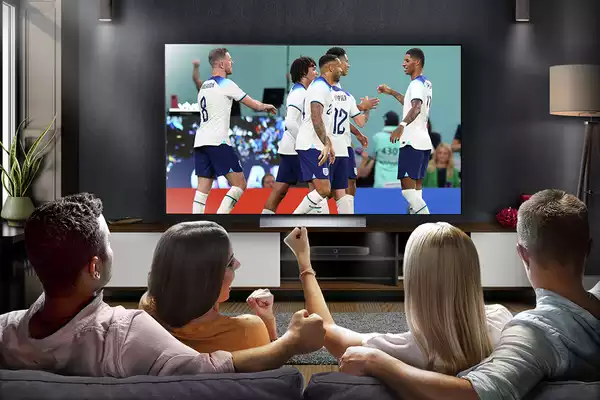
Sports are one of the most thrilling genres to watch on TV, with high-speed action, vibrant colours, and intricate details that bring the game to life. To fully enjoy the experience, optimizing your TV settings is crucial. Here’s our guide and recommendations to achieving the best settings for watching sports on TV.
Picture Mode: Sports or Dynamic
Modern TVs come with various picture modes, such as Standard, Cinema, and Dynamic. If your TV has a dedicated mode such as Sports mode, it’s best to go for this and trust the technology. If your TV doesn’t have a Sports mode, try Dynamic mode as a good alternative. These are typically the best choices as they enhance the brightness, contrast, and sharpness of the picture, making the fast-paced action clearer and more vibrant.
Motion Settings: Smooth and Clear
Motion blur can ruin the experience of watching sports, especially in high-speed games like football or motorsport. Many TVs will have motion settings to counteract this problem. While the names may vary by brand, the purpose is the same: to reduce blur and judder. Check in the Picture Settings and Advanced menus on your TV or consult your manual to see if your TV has this feature.
If available it’s good to enable these settings but avoid going to the maximum level. This can create an unnatural soap opera or airbrushed effect. Aim for a balanced level that smoothens the action without overdoing it.
Brightness and Contrast: Adjust for Detail
Sports broadcasts often include bright stadium lights and dark shadows. To capture this contrast effectively:
- Brightness: Increase it slightly to ensure details in darker areas are visible.
- Contrast: Set it to a high level to make the bright elements pop.
- Be careful not to max it out, as this can cause loss of detail in very bright scenes.
Colour Settings: Vivid but Natural
Sport in full colour is a thing of beauty, from the green of the field to the sometimes jarringly colourful kits, colours should be vibrant but natural.
- Colour Temperature: Choose a setting that leans towards cooler tones (usually called Cool or Normal) to keep whites and blues looking crisp.
- Colour Saturation: Increase it moderately to make colours more vivid without appearing cartoonish.
The best thing to do if you’re feeling brave is experiment by changing these settings bit by bit.
Sharpness: Enhancing Detail
Sharpness enhances the edges and details of the image. For sports, you want a sharp image to see the details of the game, such as the texture of the grass or the stitching on the ball. Set the sharpness to a higher level to increase the crispness of edges. We would advise again though that avoiding the maximum setting is wise. The higher the level the more change of introducing digital noise and artifacts to the picture and reduce your viewing pleasure.
Aspect Ratio: Fit to Screen
Ensure your TV’s aspect ratio is set to fit the screen properly. Most TV sports broadcasts included, are in 16:9 (widescreen) format these days. Using the correct aspect ratio ensures you’re seeing the game as intended, without any stretching or cropping.
Many TV’s will have a dedicated button on the remote to switch between modes. Otherwise, you will usually find the Aspect Ratio (sometimes called Zoom) options in the Picture Settings menu.
Sound Settings: Immersive Audio
Great visuals need to be complemented by good audio. Many TVs offer sound modes like Stadium or Sports that enhance crowd noise and commentary. If your TV has these modes, enable them to immerse yourself in the ambiance of the game. For a more advanced setup, consider using a soundbar or surround sound system.
Customising Settings
While the above settings are a great starting point, personal preferences and specific TV models can vary quite widely when looking at the extra setting available to you.
Here’s another couple of settings your TV may have that can again give you further control of your display.
- Gamma: Adjusting the gamma can help with overall picture brightness and contrast. A lower gamma setting can make shadows lighter.
- Backlight: Increase the backlight in brightly lit rooms to counteract glare.
Conclusion
Achieving the best settings for watching sports on TV can significantly enhance your viewing experience. By fine-tuning picture and sound settings, you can bring out the best in every game, making every goal, basket, or photo finish. Take the time to experiment with the settings on your TV to find the perfect balance that suits your viewing environment and personal preferences. If you're looking for a new TV, take a look at our helpful TV buying guide here.
Always consult your manual to see what options you have available to you and of course, happy watching!